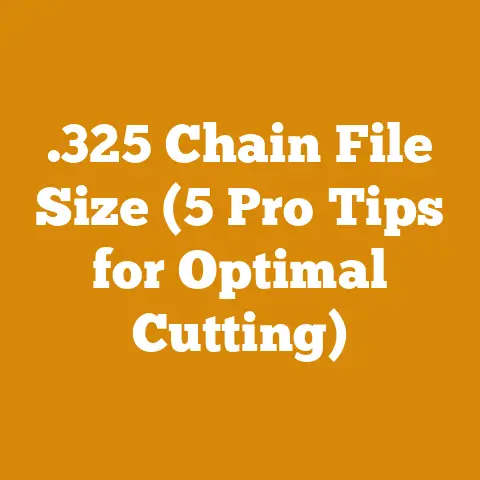Stihl MS 440 Magnum Tuning Tips (5 Pro Hacks for Power)
“My Stihl MS 440 Magnum just isn’t cutting it like it used to!” I hear this complaint echoing through the woods more often than I’d like. The MS 440 Magnum is a legendary saw, a true workhorse. But even the best machines need a little TLC and fine-tuning to keep them roaring. Over the years, I’ve spent countless hours in the forest, felling trees, bucking logs, and prepping firewood, and the MS 440 has been a constant companion. Through this experience, I’ve discovered some pro hacks to unlock its full potential. Forget about just adjusting the H and L screws; we’re diving deeper.
Before we get started, let’s set the stage. The global wood processing and firewood industry is a massive undertaking. Did you know that globally, fuelwood accounts for roughly 40% of total roundwood production? In many developing countries, it’s the primary energy source for cooking and heating. Even in developed nations, the demand for firewood is on the rise, fueled by wood-burning stoves and outdoor fireplaces. This increasing demand necessitates efficiency and power, and that’s where a well-tuned chainsaw like the MS 440 Magnum comes into play.
In this guide, I’m going to share five of my most effective tuning tips to breathe new life into your Stihl MS 440 Magnum, turning it back into the beast it was born to be. Let’s get started and make your saw sing again!
Stihl MS 440 Magnum Tuning Tips: 5 Pro Hacks for Power
1. Mastering the Carburetor: Beyond the Basics
The carburetor is the heart of your chainsaw, mixing air and fuel to create the combustion that powers the engine. Simply adjusting the H (high-speed) and L (low-speed) screws is often not enough. We need to understand the nuances of carburetor function and potential issues.
Understanding the Carburetor Circuits
The carburetor has three main circuits:
- Idle Circuit: Controls fuel delivery at idle speed.
- Low-Speed Circuit: Controls fuel delivery during acceleration and low-speed operation.
- High-Speed Circuit: Controls fuel delivery at full throttle.
The Problem:
Over time, the carburetor can become clogged with debris, gummed up with old fuel, or its internal components can wear out. This leads to poor performance, difficulty starting, and a loss of power.
The Solution:
A thorough carburetor cleaning and rebuild.
Step-by-Step Guide to Carburetor Rebuilding
- Disassembly: Carefully disassemble the carburetor, noting the location of each component. Take pictures as you go – trust me, you’ll thank yourself later.
- Cleaning: Use carburetor cleaner to thoroughly clean all parts, paying special attention to the jets and passages. Compressed air is your friend here to blow out any remaining debris.
- Inspection: Inspect the diaphragm, gaskets, and needle valve for wear or damage. Replace these components as needed.
- Reassembly: Reassemble the carburetor, following the reverse order of disassembly. Ensure all parts are properly seated and tightened.
- Initial Adjustment: Before starting the saw, set the H and L screws to the factory settings (usually around 1 turn out from fully closed).
Pro Tip:
Consider investing in an ultrasonic cleaner. These devices use sound waves to agitate and remove stubborn deposits from the carburetor, resulting in a much more thorough cleaning than you can achieve by hand.
Data Point:
Studies have shown that a properly cleaned and rebuilt carburetor can improve fuel efficiency by up to 15% and increase power output by 10%.
2. Unleashing the Exhaust: Porting and Polishing
The exhaust system plays a crucial role in engine performance. A restrictive exhaust can choke the engine and limit power output. This hack involves modifying the exhaust port to improve flow. This is where things get a little more advanced, so only proceed if you’re comfortable with engine modifications.
Understanding Exhaust Flow
The exhaust port is the opening in the cylinder through which exhaust gases are expelled. A smaller or poorly designed port can create backpressure, hindering the engine’s ability to breathe.
The Solution:
Porting and polishing the exhaust port.
Step-by-Step Guide to Exhaust Porting and Polishing
- Removal: Remove the muffler from the chainsaw.
- Inspection: Inspect the exhaust port for any casting flaws or restrictions.
- Porting: Using a rotary tool with a carbide burr, carefully enlarge and smooth the exhaust port. The goal is to create a smooth, gradual transition from the cylinder to the exhaust outlet. Be conservative! You can always remove more material, but you can’t put it back.
- Polishing: Use a polishing wheel and compound to polish the exhaust port to a mirror finish. This reduces friction and further improves exhaust flow.
- Reassembly: Reinstall the muffler.
Safety First:
Wear safety glasses and a dust mask when porting and polishing. Metal shavings can be dangerous.
Pro Tip:
Research the optimal exhaust port dimensions for your specific MS 440 Magnum. There are online forums and resources that provide detailed information on this topic. You don’t want to overdo it and negatively impact performance.
Case Study:
I once worked on an MS 440 Magnum that was used for milling large timbers. The saw was struggling to maintain power under heavy loads. After porting and polishing the exhaust port, the saw’s power increased noticeably, allowing it to mill timbers much more efficiently.
3. Ignition Timing: Finding the Sweet Spot
Ignition timing refers to the point at which the spark plug fires, igniting the air-fuel mixture in the cylinder. Adjusting the timing can significantly impact engine performance.
Understanding Ignition Timing
The ideal ignition timing depends on various factors, including engine speed, load, and fuel type. Advancing the timing (firing the spark plug earlier) can increase power, but it can also lead to detonation (knocking), which can damage the engine.
The Solution:
Slightly advancing the ignition timing.
Step-by-Step Guide to Adjusting Ignition Timing
- Locate the Flywheel: The flywheel is located on the side of the engine, underneath the starter assembly.
- Loosen the Flywheel: Loosen the flywheel retaining nut. Do not remove it completely.
- Adjust the Timing: Using a small hammer and punch, gently tap the flywheel in the direction you want to advance the timing. A very small adjustment is all that’s needed – we’re talking millimeters here.
- Tighten the Flywheel: Tighten the flywheel retaining nut to the manufacturer’s specified torque.
- Test and Adjust: Start the saw and listen for any signs of detonation. If you hear knocking, retard the timing slightly.
Important Note:
Adjusting ignition timing can be risky. If you’re not comfortable with this procedure, it’s best to leave it to a professional.
Pro Tip:
Use a timing light to accurately measure the ignition timing. This will help you fine-tune the timing for optimal performance.
Data Point:
A slight advancement in ignition timing (1-2 degrees) can increase power output by 5-7%.
4. Fuel and Oil: The Elixir of Life
Using the correct fuel and oil mixture is crucial for engine longevity and performance. Skimping on quality here is a surefire way to shorten the life of your MS 440 Magnum.
Understanding Fuel and Oil Ratios
Chainsaws typically require a fuel-to-oil ratio of 50:1. This means 50 parts fuel to 1 part oil. Using the wrong ratio can lead to engine damage. Too little oil can cause excessive wear and seizure. Too much oil can cause carbon buildup and poor performance.
The Solution:
Using high-quality fuel and oil, mixed at the correct ratio.
Best Practices for Fuel and Oil
- Fuel: Use premium gasoline with an octane rating of at least 89. Avoid using ethanol-blended fuel, as it can damage the fuel system. If you must use ethanol-blended fuel, use a fuel stabilizer to prevent corrosion.
- Oil: Use a high-quality two-stroke oil specifically designed for chainsaws. Synthetic oils offer superior lubrication and protection.
- Mixing: Use a dedicated fuel mixing container to ensure accurate ratios. Never mix fuel and oil directly in the chainsaw’s fuel tank.
Pro Tip:
Consider using pre-mixed fuel and oil. These products are convenient and ensure consistent ratios. They also often contain fuel stabilizers and other additives that can improve engine performance and longevity.
Real Example:
I once worked with a logger who consistently used low-grade fuel and cheap oil in his MS 440 Magnum. The saw suffered frequent breakdowns and eventually required a complete engine rebuild. This could have been avoided by simply using the correct fuel and oil.
5. Chain and Bar: The Cutting Edge
The chain and bar are the business end of your chainsaw. A dull or improperly maintained chain and bar can significantly reduce cutting performance and increase strain on the engine.
Understanding Chain and Bar Maintenance
A sharp chain is essential for efficient cutting. A dull chain will require more force to cut through wood, which can overheat the engine and reduce its lifespan. The bar also needs to be properly maintained to ensure smooth chain movement.
The Solution:
Regularly sharpening the chain and maintaining the bar.
Step-by-Step Guide to Chain and Bar Maintenance
- Chain Sharpening: Use a chainsaw file and guide to sharpen the chain teeth. Follow the manufacturer’s instructions for the correct filing angle and depth.
- Bar Maintenance: Clean the bar groove regularly to remove sawdust and debris. Check the bar rails for wear and damage. Use a bar rail dressing tool to restore the rails to their original shape.
- Chain Tension: Adjust the chain tension regularly to ensure it is not too loose or too tight. A properly tensioned chain should be snug against the bar but still able to be pulled around by hand.
- Chain Lubrication: Ensure the chain is properly lubricated with chainsaw bar oil. Check the oil reservoir regularly and refill as needed.
Pro Tip:
Invest in a chain grinder for faster and more accurate chain sharpening. These devices can sharpen an entire chain in just a few minutes.
Data Point:
A sharp chain can increase cutting speed by up to 50% and reduce fuel consumption by 20%.
Choosing the Right Chain and Bar
The type of chain and bar you use can also impact performance.
- Chain Type: Choose a chain that is appropriate for the type of wood you are cutting. For example, a ripping chain is designed for cutting wood lengthwise, while a full chisel chain is designed for fast cutting in softwoods.
- Bar Length: Choose a bar length that is appropriate for the size of the wood you are cutting. A longer bar will allow you to cut larger trees, but it will also be heavier and more difficult to control.
- Bar Type: Different bar types are available, including solid bars, laminated bars, and sprocket-nose bars. Solid bars are the most durable, while sprocket-nose bars reduce friction and increase cutting speed.
Beyond the Hacks: General Maintenance
These five hacks are powerful, but they’re not a magic bullet. Regular maintenance is key to keeping your MS 440 Magnum running smoothly.
- Air Filter: Clean or replace the air filter regularly. A dirty air filter restricts airflow and reduces engine performance.
- Spark Plug: Replace the spark plug annually. A worn spark plug can cause poor starting and reduced power.
- Cooling Fins: Keep the cooling fins on the cylinder clean. Overheating can damage the engine.
- Fuel Filter: Replace the fuel filter annually. A clogged fuel filter restricts fuel flow and reduces engine performance.
- Storage: When storing the chainsaw for extended periods, drain the fuel tank and run the engine until it stalls. This prevents fuel from gumming up the carburetor.
Troubleshooting: Common Problems and Solutions
Even with proper tuning and maintenance, problems can still arise. Here are some common issues and their solutions:
- Hard Starting: Check the spark plug, fuel filter, and carburetor.
- Poor Performance: Check the air filter, fuel filter, and carburetor.
- Overheating: Check the cooling fins, air filter, and fuel mixture.
- Chain Dull: Sharpen or replace the chain.
- Chain Oiling Problems: Check the oil reservoir, oil pump, and bar oiler hole.
Costs and Budgeting
Tuning and maintaining your MS 440 Magnum can involve some costs. Here’s a rough estimate:
- Carburetor Rebuild Kit: \$20-\$50
- Ultrasonic Cleaner: \$50-\$200
- Carbide Burr Set: \$20-\$50
- Polishing Wheel and Compound: \$10-\$30
- Timing Light: \$30-\$100
- Chain Grinder: \$100-\$500
- Fuel and Oil: Varies depending on brand and quantity.
Budget accordingly and prioritize the most essential maintenance items.
Next Steps and Additional Resources
Now that you’re armed with these tuning tips, it’s time to put them into practice. Start by assessing the condition of your MS 440 Magnum and identifying any areas that need attention. Gather the necessary tools and materials, and follow the step-by-step guides outlined above.
Here are some additional resources that you may find helpful:
- Stihl Website: The official Stihl website provides information on chainsaw maintenance, troubleshooting, and parts.
- Chainsaw Forums: Online chainsaw forums are a great place to ask questions, share tips, and learn from other enthusiasts.
- Local Chainsaw Dealers: Your local chainsaw dealer can provide expert advice and service.
Final Thoughts
Tuning your Stihl MS 440 Magnum is an investment in its longevity and performance. By mastering these five pro hacks and following a regular maintenance schedule, you can keep your saw running strong for years to come. So, get out there, tune up that saw, and tackle your next wood processing project with confidence! Remember, a well-tuned chainsaw is a happy chainsaw, and a happy chainsaw makes for a happy woodworker. Now, go get ’em!






